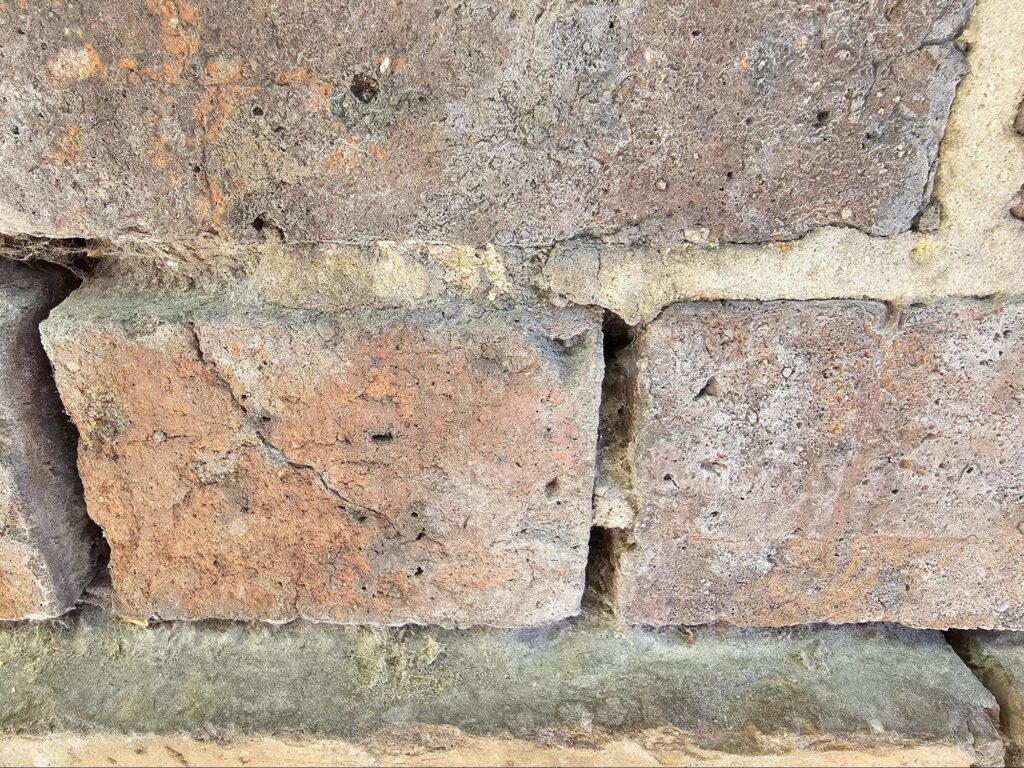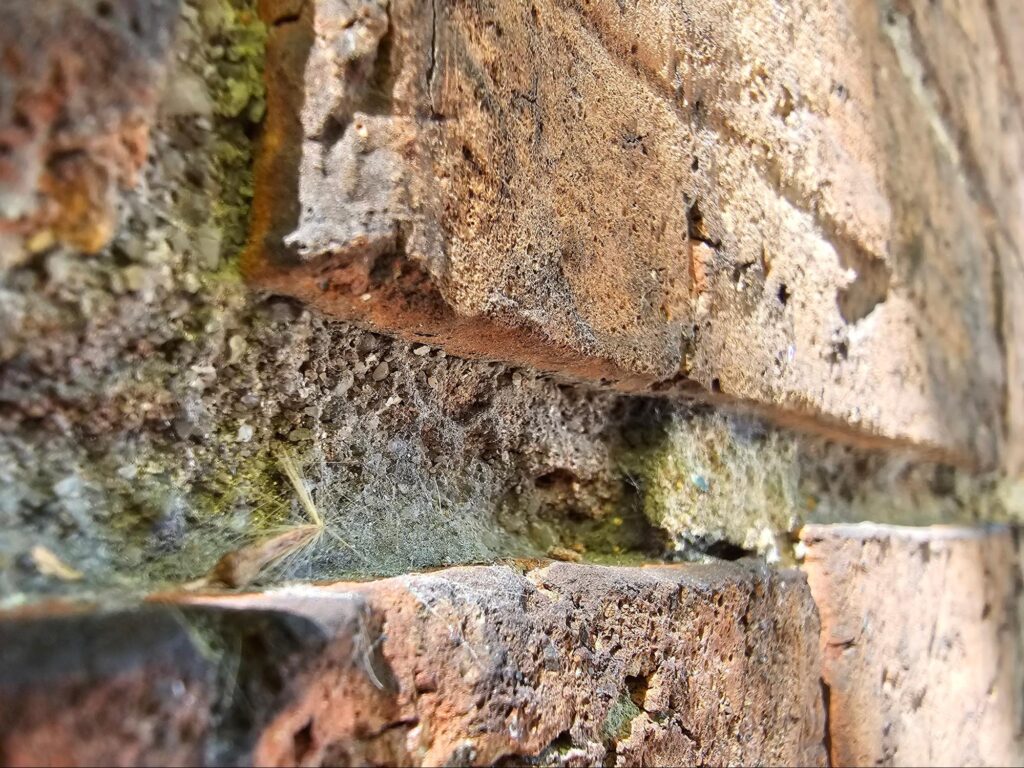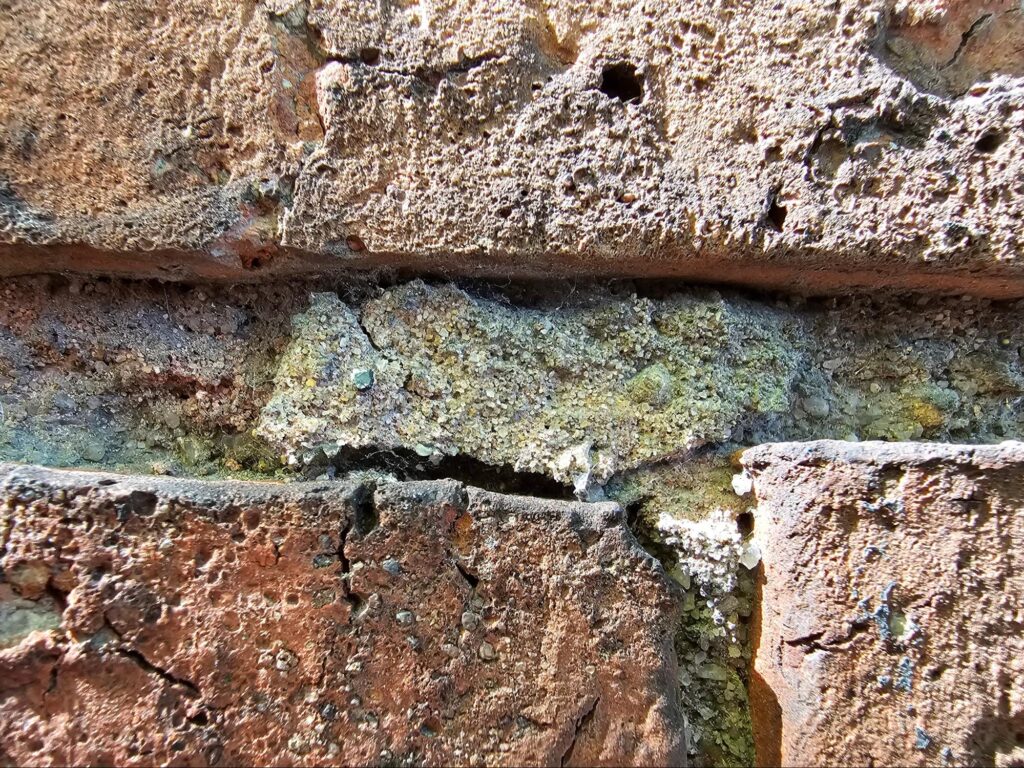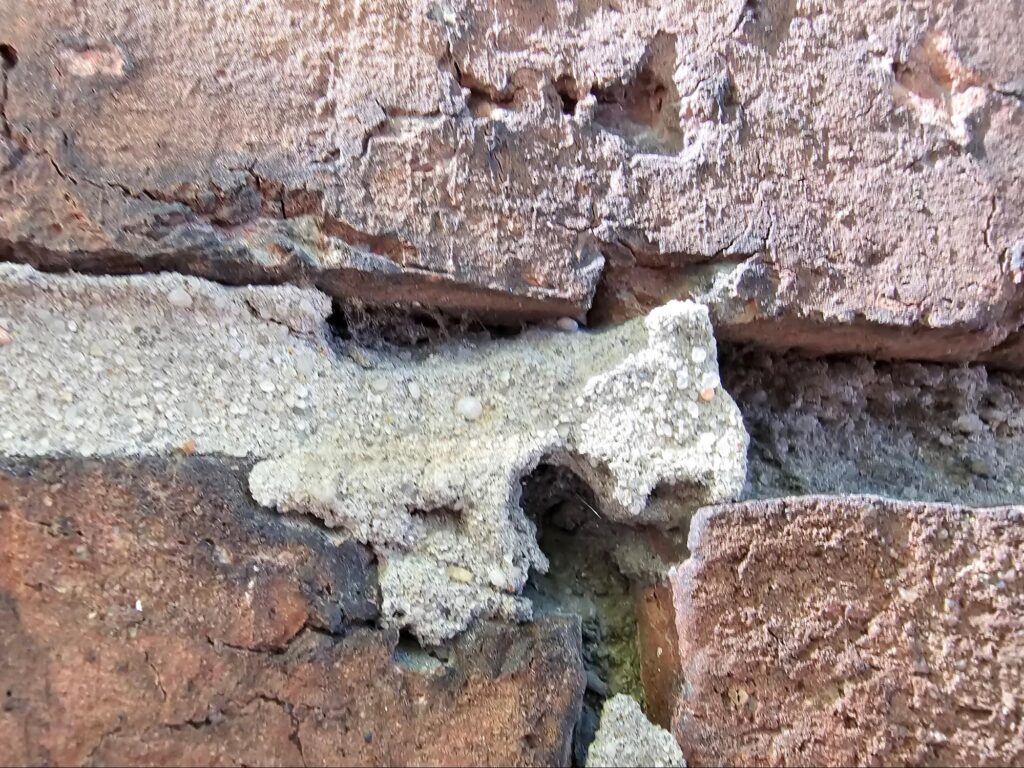Table of Contents
ToggleThe Role of Mortar in Historic Buildings
Mortar, the binding agent used in masonry construction, plays a crucial role in the stability and longevity of historic buildings. Composed of a mixture of lime, sand, and water, traditional mortars were crafted with care and skill, often using locally sourced materials. Over time, these mortars cure and harden, forming a strong bond with the surrounding masonry units—whether brick, stone, or adobe.
Beyond structural support, lime mortar, to a degree, can also serve as a buffer against the forces of nature. Mortar is a conforming interface between individual masonry units, allowing for slight movement and accommodating changes in temperature, humidity, and settling. Additionally, mortar contributed to the aesthetic appeal of historic buildings, with different formulations and finishes lending to unique applications in building restoration.

(The picture below shows an example of severely deteriorated mortar joints in a historic masonry wall in need of repointing.)
Mortar, in historic brick masonry construction, serves as a binding agent that holds individual bricks or stones together, providing structural integrity and durability. However, even the most well-crafted mortar is susceptible to deterioration over time due to various environmental factors and the inherent nature of its components.
The Main Types of Deterioration in Historic Mortar
At its core, mortar is a composite material consisting of a binder (typically lime or cement), aggregates (sand or crushed stone), water, and sometimes additives like pigments or air-entraining agents. While these components initially form a strong and durable matrix, their molecular properties and interactions can lead to gradual breakdown and deterioration.
Calcium Carbonate (CaCO3) Breakdown
Lime-based mortars, commonly used in historic masonry, rely on calcium carbonate as a primary binder. Over time, this compound can undergo chemical reactions with atmospheric carbon dioxide and water, a process known as carbonation. On a molecular level, carbon dioxide dissolves in water, forming carbonic acid (H2CO3), which then reacts with calcium compounds in the mortar, leading to the formation of insoluble calcium carbonate crystals. This process can cause the mortar to become brittle and lose its binding strength.

Aggregate Deterioration
The aggregates in mortar, typically sand or crushed stone, can also contribute to deterioration. These materials are susceptible to physical and chemical weathering processes, such as freeze-thaw cycles, salt crystallization, and acid attack. On a molecular level, these processes can weaken the bonds between the aggregate particles and the binder, leading to cracking, spalling, and eventual loss of cohesion within the mortar matrix.
Water Infiltration and Freeze-Thaw Cycles
Water is an essential component in the initial hydration and curing of mortar, but its presence can also contribute to long-term deterioration. Over time, water can penetrate the porous structure of mortar, facilitating the leaching of soluble compounds and promoting the growth of salts, which can exert internal pressures and cause cracking or spalling. Additionally, repeated freeze-thaw cycles can lead to the expansion and contraction of water within the mortar’s pores, causing internal stresses and potential cracking or delamination.

Chemical Reactions and Pollution
Mortar can also be affected by chemical reactions with environmental pollutants, such as sulfur dioxide (SO2) and nitrogen oxides (NOx). These compounds can react with the calcium compounds in the mortar, forming gypsum (CaSO4·2H2O) or calcium nitrate (Ca(NO3)2), which can cause the mortar to weaken and deteriorate over time.
As these processes unfold over decades or centuries, the once strong and durable mortar gradually loses its binding strength, cohesion, and integrity. Cracks, erosion, and loss of material can occur, compromising the structural stability of the masonry and necessitating repointing or tuckpointing interventions to restore the mortar and ensure the longevity of the historic masonry structure.

Weather factors and Human Caused Deterioration
Despite its durability, historic mortar is susceptible to a variety of deterioration mechanisms, exacerbated by environmental factors, moisture ingress, and human intervention. Over time, exposure to moisture and freeze-thaw cycles can cause mortar to erode and crumble, compromising the integrity of the masonry structure. In regions prone to seismic activity, mortar joints may experience cracking and displacement, leading to instability and potential collapse.
Furthermore, the use of incompatible modern materials, such as Portland cement-based mortars, in restoration efforts can exacerbate deterioration and accelerate damage. These hard, impermeable mortars lack the flexibility and breathability of traditional lime-based mortars, trapping moisture within the masonry and hastening decay.
Preservation Challenges
Preserving historic mortar presents a unique set of challenges. Unlike modern construction materials, which can be easily replaced or repaired, historic mortar must be carefully analyzed and replicated using traditional methods and materials. Matching the composition, texture, and color of historic mortar requires a deep understanding of local geological sources and historical construction practices.
Moreover, the conservation process must balance the need for structural stability with the desire to maintain the authenticity and character of the original building.
Tuckpointing and re-pointing—removing deteriorated mortar and replacing it with new mortar—is often necessary to prevent further damage and ensure the structural integrity of the masonry. The process of repointing can be somewhat complicated, but with a good contractor it can be handled professionally. There are tons of people out there in the Washington DC area though doing this type of construction without doing it properly and it’s easier and much better just to have someone who knows what they’re doing and can do it right.
Our company, Dupont Tuckpointing and Masonry, specializes in masonry restoration, historic brick repointing, and tuckpointing services in the Washington D.C. area. These buildings are uniquely historic, and their preservation requires skilled masons who are technically trained in the best practices and knowledge of proper restoration techniques.
We understand the significance of maintaining the architectural integrity of these historic structures, and our team of experienced professionals is dedicated to delivering exceptional craftsmanship. Whether you require masonry restoration, tuckpointing, or brick repointing services, we are here to help.
At Dupont Tuckpointing and Masonry, we take pride in our work and strive to ensure that every project is executed with the utmost care and attention to detail. We are committed to preserving the rich heritage of Washington D.C.’s built environment for generations to come.
If you have any questions or needs regarding masonry restoration, historic brick repointing, or tuckpointing services, please do not hesitate to reach out to us. We would be delighted to assist you and provide you with the expertise and quality workmanship that your historic property deserves.
You can reach us by telephone at (202) 796-7644 and you can reach us by email from the contact form on our website at https://duponttuckpointingmasonrydc.com/contact-us/.




